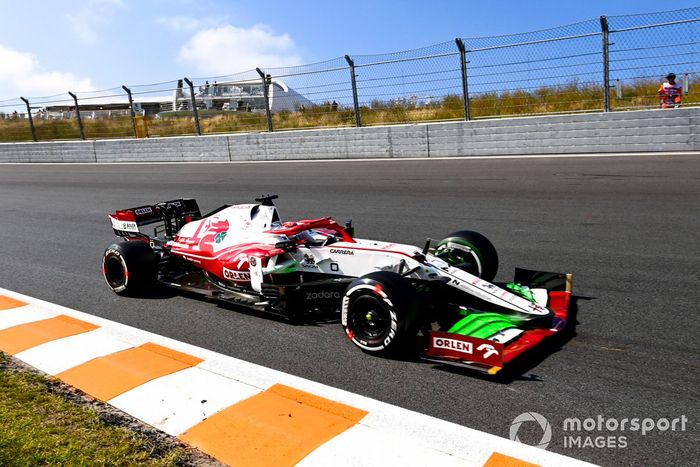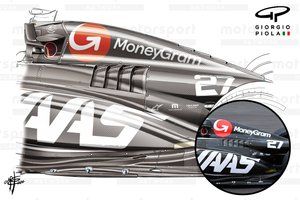A close-up of the new angled strake added by Red Bull at the Belgian GP near the Z-Shaped cutout, whilst the strake that’s connected to the floor edge and the detached floor scrolls has also been arched over more at the top too.
The Red Bull mechanics can be seen here preparing the RB16B for the weekend's action but also note the front brake drum which has the bypass pipework exposed allowing us to see the surface coating used to reduce the transfer of heat.
This photo of the Mercedes W12 allows us to appreciate a number of fine details, included the twisted vane that connects the horizontal pod wing and the floor and the two clusters of outwardly winglets on the front section of the floor, which you'll note have different vertical curvature to encourage the airflow to behave the way they expect.
As the Mercedes mechanics carry the nose and front wing away from the stand we can see the shape of the cape, which forms a boat tail at the rear.
As they carry it into the garage we get a rare glimpse of the underside of the nose and front wing too.
A look at the Alpine A521's bargeboard cluster and sidepod deflector, which as you'll note has some metalwork applied in order to prevent the sections flexing and the gaps closing.
A look at the Alpine A521's rear end noting the metal dots on the rear surface which denote where the metal stiffeners connect to the various sections on the front. Also note the shape of the shroud around the rain light with the cutouts projected rearwards as the upper flap of the crash structure extends further back.
Alpine have been running their rear wing with these stiffeners on the rear wing endplate since the new flexi-wing tests have been put in place.
The rear end of the Mercedes W12 which you'll note has been set up with the double rear wing mounting pillars, Y-shaped T-Wing support and a small cooling outlet.
Side view of the Mercedes W12 gives us an insight into the intricacy of the surfaces used to manipulate the airflow around the sidepod and floor. You can even see the slight kink in the leading edge of the floor, where the outer section is retracted slightly more than the inner portion.
Another angle of the W12's rear wing with its elongated swan neck mounting pillars, whilst also worth noting the serrated edges on the back of the DRS actuator pod.
Another angle on the Alpine A521 from the rear and note what appear to be some on-site repairs to the joint in the rear wing endplate.
A rare view of the Aston Martin AMR21's front wing, nose and cape from behind, note the interior footplate on the front wing which is used to help direct the flow in that region.
The design of the AMR21 still has some of the core DNA of the W10 its brethren was so obviously derived from but Aston Martin have worked hard on their own concepts too, as they looked for ways to overcome the rule changes that hampered them early-on this season. Note the significant floor cutout around which the crescent-shaped array of winglets are mounted, whilst a quartet of outwardly angled winglets help the airflow ahead.
Upstream of this we can see how complex all of the surfaces that make up the bargeboard cluster have become, with the upper surface of the main element that protrudes above the boomerang, fanned out and slotted to improve flow consistency across a range of conditions.
This side view of the Red Bull RB16B's front end shows how the suspension fairings and flexures have been curated to provide aerodynamic assistance, whilst the chassis horns and narrow 'S' duct are a design that mark them out from the rest of the grid.
A great view of the McLaren MCL35M's Z-shaped floor cutout and outwardly angled fins, which you'll note are angled differently at different points on the floor.
A nice close-up of the winglets mounted on the side of the McLaren MCL35M's crash structure and the ladder winglet mounted between it and the diffuser. Also note the little duck bill winglet on the end of the crash structure.
A magnificent overview of the Red Bull RB16B's bargeboard cluster, sidepod deflectors and the strakes on the leading edge of the floor. Note the slots in the boomerangs surface which mirror the slots in the footplate below for legality purposes.
The area ahead of the rear tyre on the Red Bull RB16B with an array of different shape and length strakes and winglets used to help direct the airflow across and around the rear tyre.
A close-up of the five angled fins in front section of the RB16B's floor.
Red Bull don't use the RB16B's steering wheel for pitstop practice, instead favouring an older model without the large PCU-8D display mounted in it.
A close-up of the RB16B's bargeboard cluster shows the slots in the surfaces more clearly.
As the mechanics prepare to practice a front wing change during a pitstop we get to see how the nose and cape are made up and you'll note a tunnel section is created in the central section to help channel airflow through from the front of the car.
A nice overview of the Mercedes W12's front brake duct assembly, which you'll note that without the wheel attached the inlet travels further down the front face than you'd expect.
A shot of the front brake duct from the side gives an indication of how big the internal bypass channel at the front of the assembly is.
An unusual shot of the rear suspension and brake duct without the wheel being in place shows how airflow is channeled through and around the various components on the W12. Also note the strakes mounted on the floor ahead of the rear brakes which are used to help divert the airflow across and around the rear tyre.
This shot of the RB16B's bargeboard cluster shows how the outer section of the boomerang is split into two levels in order that it interacts with the sidepod deflector alongside more effectively.
As the Red Bull mechanics deliberate an issue with a wheel nut we're treated to a view of the rear brake duct winglet and suspension.
There's nothing new to see in this shot of the Alfa Romeo C41 but it is worth noting some of the features on show, including the outwardly angled strakes in the low section of the rear wing endplate and their novel low-line engine cover.
Looking at the Alpine A521's front wing from this angle you can't fail to notice how the upper surface of the footplate falls away, allowing for the formation of the two outwardly angled fins at the rear, which help with outwash.
A great view of the aero surfaces that dominate the outer shoulder of the Alpine A521, with curvature of the sidepod wing clear to see from this angle.
The Alfa Romeo C41's front wing is sprayed with flo-viz paint as the team look for visual confirmation that the airflow is behaving as expected
Mercedes applied flo-viz paint to the lower wishbone at the front of Lewis Hamilton's car during FP1 in order to make sure the airflow over and under the aerodynamic fairing was acting as they anticipated.


















































Top Comments